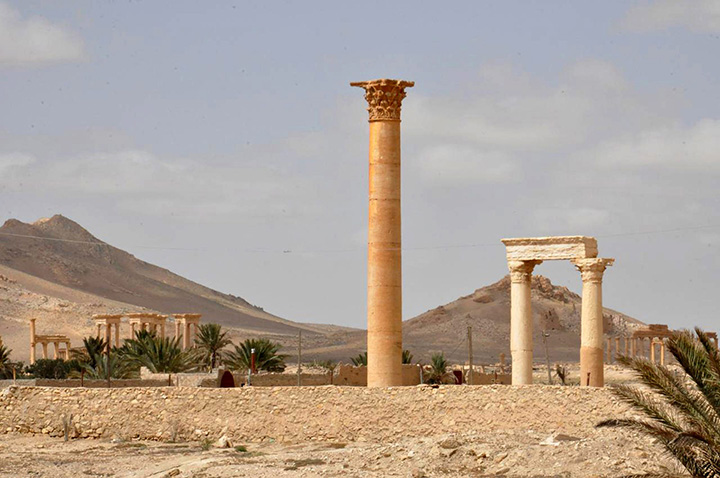DAMASCUS, Syria — Syrian antiquities experts expressed shock Monday at the destruction the Islamic State group wrought inside Palmyra’s museum, where scores of artifacts were smashed before troops drove the extremists out of the historic town.

Syria’s head of antiquities and museums, Maamoun Abdul-Karim, told The Associated Press that a team from his department will head to Palmyra later in the day to estimate the losses. Abdul-Karim said he would go himself once bomb squads finish removing explosives planted by the extremists before they lost the town.
The recapture of Palmyra by Syrian government forces on Sunday was an important victory over IS fighters who had waged a 10-month reign of terror there. It also marked the first major defeat for the extremist group since an international agreement to battle terrorism in the fractured nation took effect last year.
During their rule of Palmyra, the extremists demolished some of its best-known artifacts and monuments, including two large temples dating back more than 1,800 years and a Roman triumphal archway. The sprawling outdoor site was one of Syria’s main tourist attractions before the civil war.
READ MORE: Fighting against ISIS rages in central Syrian town of Palmyra
IS also killed scores of people, including the archaeological site’s 81-year-old director, Riad al-Asaad, who was beheaded in August after he reportedly refused to divulge where authorities had hidden some of the treasures before IS captured the town. The militants also demolished Palmyra’s infamous Tadmur prison, where thousands of government opponents were reportedly tortured.
The Sunni extremist group, which has imposed a violent interpretation of Islamic law across the territory it controls in Syria and Iraq, claims ancient relics promote idolatry and says it is destroying them as part of a purge of paganism — though it is also believed to have sold looted antiquities to finance its operations.
Speaking to the AP over the phone, Abdul-Karim said experts still need “many days” to determine the full extent of the damage.
Before Palmyra fell to IS, authorities were able to rescue more than 400 statues and hundreds of artifacts that were moved to safe areas, he said, but larger statues couldn’t be moved.
On Sunday, state TV showed the rubble left over from the destruction of the Temple of Bel in Palmyra, as well as the damaged archway, the supports of which are still standing.

Get daily National news
Artifacts inside the city’s museum also appeared heavily damaged on state TV. A sculpture of the Greek goddess Athena was decapitated, and the museum’s basement appeared to have been dynamited, the hall littered with broken statues.

Amr al-Azm, a former Syrian antiquities official who is now a professor at Shawnee State University in Ohio, said the world was already aware of the damage to the archaeological site, which had been documented by IS in online videos, but was only now seeing the destruction wrought inside the museum.
“What was unfortunate really was the damage inside the (Palmyra) museum, the many of the pieces that have not been saved, that they (Damascus officials) did not have time or the ability to move,” Al-Azm said via Skype. “It seems that a significant amount of damage was inflicted on them.”
READ MORE: Syrian forces, Russian airstrikes target ISIS-held Palmyra
Still, state media reported that a lion statue dating back to the second century, previously thought to have been destroyed by IS militants, was found in a damaged but recoverable condition.
Abdul-Karim said that IS fighters smashed the statues’ faces but didn’t totally destroy them. “We can renovate them,” he said. “Yes, we lost part of the original but we didn’t totally lose them.”
“All smashed statues can be renovated as they were not totally destroyed,” he said.
Syrian military bomb squads worked Monday on removing mines and bombs planted by IS across much of Palmyra, including residential areas as well as the historic quarter, an official said on condition of anonymity in line with regulations.
The Lebanon-based Hezbollah TV stations — Al-Manar and Al-Mayadeen — which have both reported from inside Palmyra, showed videos of explosions inside the town on Monday, saying that Syrian troops are detonating explosives that are difficult to dismantle.
The government forces had the support of Iranian-backed Lebanese militias and Russian air power in the advance on Palmyra.
Russian President Vladimir Putin on Monday called Iranian leader Hassan Rouhani to discuss Syria. Both leaders described the retaking of Palmyra as a “true landmark event” according to the Kremlin’s website.
Kremlin spokesman Dmitry Peskov said that it was only a small, though important, part of the Russian air force that supported the operation.
During a Monday conference call with reporters, Peskov said that even though a large part of the Russian military has left Syria, the remaining air assets will continue to fight “terrorist groups” and help the Syrian army.
___
Associated Press writers Bassem Mroue in Beirut and Katherine Jacobsen in Moscow contributed to this report.








Comments